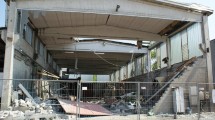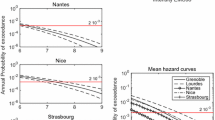Abstract
A review of damage scales for buildings is carried out with a view to assessing their suitability for use in earthquake loss modelling in Europe. A new ranking system is proposed to ‘score’ each scale. The ranking considers damage descriptions, building response factors, repair, cost of damage and ease of use, which are identified as the key characteristics required of damage scales used in loss modelling. The ‘hybrid’ RISK-UE damage scale (which uses a HAZUS-based approach) is seen to score high in the ranking, whilst ‘hybrid’ scales based on the EMS-98 damage scales perform poorly. However, it is found that none of the considered damage scales adequately satisfy all the criteria necessary for their use in European seismic loss estimation, especially with respect to inclusion of likely repair methods and damage costs. The development of cross-country loss models often involves using vulnerability curves or post-earthquake survey data that are commonly expressed in terms of different damage scales. Equivalence tables, showing the relationship between the damage states of each considered scale, are therefore also presented for the predominant structural systems in Europe.
Similar content being viewed by others
References
Akkar S, Sucuoglu H, Yakuta A (2005) Displacement-based fragility functions for low- and mid-rise ordinary concrete buildings. Earthquake Spectra 21: 901–927
Bertogg M, Hitz L, Schmid E (2002) Vulnerability functions derived from loss data for insurance risk modelling: findings from recent earthquakes. In: Proceedings of the twelfth European conference on earthquake engineering (paper 281), London, September 2002
Bommer J, Spence R, Erdik M, Tabuchi S, Aydinoglu N, Booth E, Del Re D, Peterken O (2002) Development of an earthquake loss model for Turkish catastrophe insurance. J Seismol 6: 431–436
Blong R (2003a) A review of damage intensity scales. Nat Haz 29: 57–76
Blong R (2003b) A new damage index. Nat Haz 30: 1–23
Building Seismic Safety Council National Institute of Building Sciences (BSSC) (2003) NEHRP recommended provisions and commentary for seismic regulations for new buildings and other structures, 2003 Edition (FEMA 450). Washington
Calvi G (1999) A displacement-based approach for vulnerability evaluation of classes of buildings. J Earthquake Eng 3: 411–438
Carvalho E, Coelho E, Campos-Costa A, Sousa M, Candeias P (2002) Vulnerability evaluation of residential buildings in Portugal. In: Proceedings of the twelfth European conference on earthquake engineering (paper 696), London, September 2002
Comité Européen de Normalization (CEN) (2004) Eurocode 8: Design of structures for earthquake resistance—Part 1. General rules, seismic actions and rules for buildings (EN 1998–1). Brussels
Coburn A, Spence R (2002) Earthquake protection, 2nd edn. Wiley, Chichester
Crowley H, Pinho R, Bommer J (2004) A probabilistic displacement-based vulnerability assessment procedure for earthquake loss estimation. Bull Earthquake Eng 2: 173–219
Di Pasquale G, Orsini G, Romeo R (2005) New developments in seismic risk assessment in Italy. Bull Earthquake Eng 3: 101–128
Dolce M, Masi A, Marino M, Vona M (2003) Earthquake damage scenarios of the building stock of Potenza (Southern Italy) including site effects. Bull Earthquake Eng 1: 115–140
Ergonul S (2005) A probabilistic approach for earthquake loss estimation. Struct Saf 27: 309–321
Federal Emergency Management Agency (FEMA) (1994) Assessment of state-of-the-art earthquake loss estimation methodologies, Report No. 249. Washington
Federal Emergency Management Agency (FEMA) (1999) Earthquake loss estimation methodology earthquake HAZUS99 Service Release 2 (SR2) technical manual. Washington
FEMA (2000) Prestandard and commentary for the seismic rehabilitation of buildings, Report No. 356. Washington
FEMA (2003) Multi-hazard loss estimation methodology earthquake model HAZUS-MH MR1 advanced engineering building module technical and user’s manual. Washington
Ghobarah A (2001) Performance-based design in earthquake engineering: state of development. Eng Struct 23: 878–884
GNDT (2007) Manuale per la compilazione della scheda di 1° livello di rilevamento danno, pronto intervento e agibilità per edifici ordinari nell’emergenza post-sismica. Available at (In Italian): http://www.ingv.it/gndt/Pubblicazioni/Bernardini/Man_Aedes/Manuale/ManualeIndice.html, accessed: 13/09/07
Goretti A, Di Pasquale G (2004) Building inspection and damage data for the 2002 Molise, Italy, earthquake. Earthquake Spectra 20: S167–S190
Grünthal G (ed) (1998) European macroseismic scale 1998. European Seismological Commission, Luxembourg
Istituto Nazionale di Statistica (ISTAT) (2004) Edifici ed abitazioni Censimento 2001 Dati definitive. In: 14° Censimento Generale della Popolazione e delle Abitazioni. Istituto Nazionale di Statistica. Available at: http://dawinci.istat.it/daWinci/jsp/MD/download/edifici_abitazione2004.pd. Cited 04 April 2007
Kappos A, Stylianidis K, Penelis G (1991) Analytical prediction of the response of structures to future earthquakes. Eur Earthquake Eng 5: 10–21
Kappos A, Stylianidis K, Pitilakis K (1998) Development of seismic risk scenarios based on a hybrid method of vulnerability assessment. Nat Haz 17: 177–192
Kappos A, Panagopoulos G, Panagiotopoulos C, Penelis G (2006) A hybrid method for the vulnerability assessment of R/C and URM buildings (RISK-UE). Bull Earthquake Eng 4: 391–413
Khudiera S, Mohammadi J (2006) Assessment of potential seismic damage to residential unreinforced masonry buildings in Northern Illinois. Pract Period Struct Design Construction 11: 93–97
Kircher C, Reitherman R, Whitman R, Arnold C (1997) Estimation of earthquake losses to buildings. Earthquake Spectra 13: 703–720
Lang K, Bachmann H (2004) On the seismic vulnerability of existing buildings: a case study of the city of basel. Earthquake Spectra 20: 43–66
Lagomarsino S, Giovinazzi S (2006) Macroseismic and mechanical models for the vulnerability and damage assessment of current buildings (RISK-UE). Bull Earthquake Eng 4: 415–443
Lungu D, Aldea A, Arion C, Vacareanu R, Petrescu F, Cornea T (2001) An advanced approach to earthquake risk scenarios with applications to different European towns, RISK-UE Report WP1: European distinctive features, inventory database and typology. European commission, Brussels. Available at: ftp://ftp.brgm.fr/pub/RISK-UE/Handbooks_Methodology/WP01_020307.pdf, Accessed: 24/08/07
Milutinovic Z, Trendafiloski G (2003). An advanced approach to earthquake risk scenarios with applications to different European towns, RISK-UE Report WP4: vulnerability of current buildings. European Commission, Brussels. Available at: ftp://ftp.brgm.fr/pub/RISK-UE/Handbooks_Methodology/WP04_040305.pdf, Accessed: 24/08/07
Okada S, Takai N (2000) Classifications of structural types and damage patterns of buildings for earthquake field investigation. In: Proceedings of the 12th world conference on earthquake engineering (paper 0705), Auckland, February 2000
Pagni CA, Lowes LN (2006) Fragility functions for older reinforced concrete beam-column joints. Earthquake Spectra 22: 215–238
Pitilakis K, Kappos A, Hatzigogos T, Anastasiadis A, Alexoudi M, Argyroudis S, Penelis G, Panagiotopoulos Ch, Panagopoulos G, Kakderi K, Papadopoulos I, Dikas N (2004) An advanced approach to earthquake risk scenarios with applications to different European towns, RISK-UE Report WP14: synthesis of the application to Thessaloniki city. European Commission, Brussels. Available at: ftp://ftp.brgm.fr/pub/RISK-UE/Reports_Cities_Application/WP14_Thess_040322.pdf, Accessed: 24/08/07
Priestley M (1997) Displacement-based seismic assessment of reinforced concrete buildings. J Earthquake Eng 1: 157–192
RISK-UE BEE special edition (2006) RISK-UE project special edition. Bull Earthquake Eng 4:319--463
RISK-UE project website (2007) Available at: http://www.risk-ue.net/ Accessed: 24/08.07
Roca A, Goula X, Susagna T, Chavez J, Gonzalez M, Reinoso E (2006) A simplified method for vulnerability assessment of dwelling buildings and estimation of damage scenarios in Catalonia. Bull Earthquake Eng 4: 141–158
Rossetto T, Elnashai A (2003) Derivation of vulnerability functions for European-type RC structures based on observational data. Eng Struct 25: 1241–1263
Rossetto T, Elnashai A (2005) New analytical procedure for the derivation of displacement-based vulnerability curves for populations of RC structures. Eng Struct 27: 397–409
Structural Engineers Association of California (SEAOC) (1995) Vision 20007—A framework for performance based earthquake engineering. Structural Engineers Association of California, Sacramento
Swiss Seismological Service (SSS) (2006) Global seismic hazard map. Global Seismic Hazard Assessment Program, Geneva
Whitman R, Anagnos T, Kircher C, Lagorio H, Lawson R, Schneider P (1997) Development of a national earthquake loss estimation methodology. Earthquake Spectra 13: 643–661
Vacareanu R, Lungu D, Aldea A, Arion C (2004) An advanced approach to earthquake risk scenarios with applications to different European towns, Report WP7: Seismic Risk Scenarios Handbook. European Commission, Brussels. Available at: ftp://ftp.brgm.fr/pub/RISK-UE/Handbooks_Methodology/WP07_040408.pdf, Accessed: 24/08/07
Author information
Authors and Affiliations
Corresponding author
Rights and permissions
About this article
Cite this article
Hill, M., Rossetto, T. Comparison of building damage scales and damage descriptions for use in earthquake loss modelling in Europe. Bull Earthquake Eng 6, 335–365 (2008). https://doi.org/10.1007/s10518-007-9057-y
Received:
Accepted:
Published:
Issue Date:
DOI: https://doi.org/10.1007/s10518-007-9057-y




